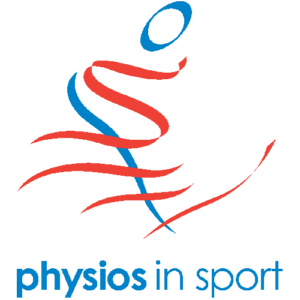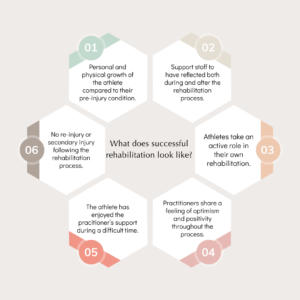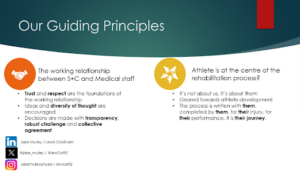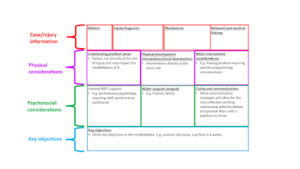A collaborative rehabilitation framework involving the dual-discipline support of physiotherapy and strength & conditioning (S&C). To assist the athlete’s journey from injury to performance.
Keywords: Athlete-centred rehabilitation; rehabilitation framework; multi-disciplinary team (MDT) working

Introduction:
The interaction between physiotherapists and S&C coaches throughout an athlete’s rehabilitation is a significant one. They work closely from injury onset through to return to performance (RTP), placing the athlete at the centre of the process.
This blog series explores the components to achieve a coherent, athlete-centred, performance-focussed rehabilitation approach and the role collaboration plays between physiotherapy and S&C practitioners during their support of the injured athlete.
Part-one focuses on the principles including: the working relationship between S&C coach and physiotherapists, outcomes for the rehabilitation process and how these roles support the athlete’s RTP journey. Additionally, the aspects of assessment and planning will be outlined when starting the rehabilitation process.
S&C and Physiotherapist working relationship – the magic formula:
To offer optimal rehabilitation, S&C and physiotherapy practitioners must first identify the key themes of successful rehabilitation, have a clear process in place and follow principles that guide their working relationship (see figure 1).

Figure 1: Key themes of a successful rehabilitation
Despite the rehabilitation focus being the athlete’s health and successful RTP, a strong working relationship between S&C and physiotherapists in an athlete’s RTP process is vital. The cohesion of this relationship is determined by an agreed set of values:
- Trust and respect being the foundations of the working relationship.
- Ideas and diversity of thought being encouraged.
- Decisions made with transparency, robust challenge and collective agreement.
- Egos are left at the door. It is not about us, it is about the athlete.
With those guiding principles agreed, the components of how both disciplines work at each rehabilitation stage to maximise the athlete’s chance of a successful rehabilitation can be established and commenced (see Figure 2).

Figure 2: Guiding principles of the physiotherapist and S&C coach working relationship
Assess and plan:
The first step is to assess the injury and contextual factors surrounding the case, then plan. The assessment establishes the ‘what’. The plan establishes the ‘how’. These are both fluid in nature and change with time.
Assessment of the athlete’s case requires looking holistically at the problem, ensuring it takes into account the inevitably complex nature of injuries (1). Combining physiotherapeutic assessment post-injury with information gathered by S&C coaches, such as physical profile testing, can help to inform the plan. The assessment areas can be split into four main sections (see figure 3), with an overview sheet that allows the key stakeholders to contribute collaboratively to the case. Key objectives form part of the plan, whereby important stepping stones in the rehabilitation process can be agreed and actioned. Once fully assessed and planned, the RTP process can be efficiently and safely prioritised and programmed.

Figure 3: MDT planning sheet (2)
Conclusions:
- Ensuring physiotherapy and S&C practitioners agree on principles to their working relationship, creates a strong foundation for rehabilitation cases
- Working collaboratively as an MDT during the assessment of an athlete’s case provides a holistic view, identifying physical and psychosocial factors and key objectives
- Clear planning from key stakeholders offers an agreed direction of travel, and promotes effective and efficient rehabilitation processes
Acknowledgements:
Thank you to the ACPSEM (@physiosinsport) for supporting this blog.
Competing Interests – None
Jake Mulley BSc (Hons), MCSP, ACPSEM Bronze Accreditation. Clinical Lead/Senior Physiotherapist working in private practice. LinkedIn: Jake Mulley, Instagram: jakemulleyphysio, X: @jake_mulley
Lewis Coldham BSc (Hons). Strength and Rehabilitation Coach and Educator. LinkedIn: Lew Coldham, Instagram: lewcol92, X: @lewCol92
References:
- Bittencourt NFN, Meeuwisse WH, Mendonça LD, Nettel-Aguirre A, Ocarino JM, Fonseca ST. Complex systems approach for sports injuries: moving from risk factor identification to injury pattern recognition-narrative review and new concept. Br J Sports Med. 2016 Nov;50(21):1309-1314. doi: 10.1136/bjsports-2015-095850. Epub 2016 Jul 21. PMID: 27445362.
- Hazlett, A., 2020. Physiotherapy Art vs Science